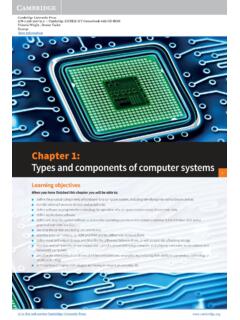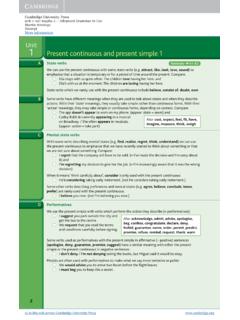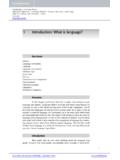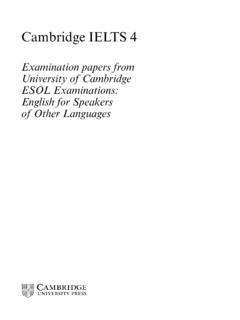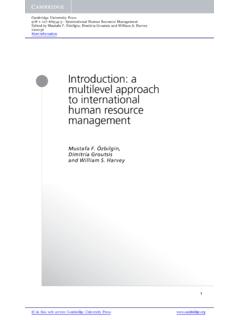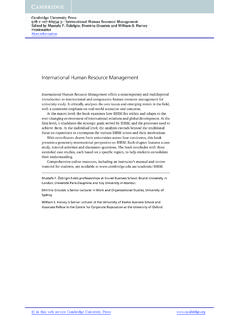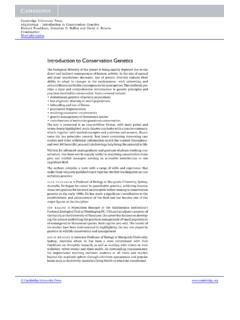Transcription of Matrix Analysis - Cambridge University Press
1 Cambridge University Press 978-0-521-83940-2 Matrix Analysis Roger A. Horn , Charles R. Johnson Frontmatter More Information Matrix Analysis Second Edition Linear algebra and Matrix theory are fundamental tools in mathematical and physical science, as well as fertile fields for research. This new edition of the acclaimed text presents results of both classic and recent Matrix Analysis using canonical forms as a unifying theme, and demonstrates their importance in a variety of applications. The authors have thoroughly revised, updated, and expanded on the first edition. The book opens with an extended summary of useful concepts and facts and includes numerous new topics and features, such as: r New sections on the singular value and CS decompositions r New applications of the Jordan canonical form r A new section on the Weyr canonical form r Expanded treatments of inverse problems and of block matrices r A central role for the von Neumann trace theorem r A new appendix with a modern list of canonical forms for a pair of Hermitian matrices and for a symmetric skew symmetric pair r Expanded index with more than 3,500 entries for easy reference r More than 1,100 problems and exercises, many with hints, to reinforce understand- ing and develop auxiliary themes such as finite-dimensional quantum systems, the compound and adjugate matrices, and the Loewner ellipsoid r A new appendix provides a collection of problem-solving hints.
2 Roger A. Horn is a Research Professor in the Department of Mathematics at the University of Utah. He is the author of Topics in Matrix Analysis ( Cambridge University Press 1994). Charles R. Johnson is the author of Topics in Matrix Analysis ( Cambridge University Press 1994). in this web service Cambridge University Press Cambridge University Press 978-0-521-83940-2 Matrix Analysis Roger A. Horn , Charles R. Johnson Frontmatter More Information Matrix Analysis Second Edition Roger A. Horn University of Utah Charles R. Johnson in this web service Cambridge University Press Cambridge University Press 978-0-521-83940-2 Matrix Analysis Roger A. Horn , Charles R. Johnson Frontmatter More Information One Liberty Plaza, 20th Floor, New York, NY 10006, USA. Cambridge University Press is part of the University of Cambridge .
3 It furthers the University 's mission by disseminating knowledge in the pursuit of education, learning, and research at the highest international levels of excellence. Information on this title: . C Roger A. Horn and Charles R. Johnson 1985, 2013. This publication is in copyright. Subject to statutory exception and to the provisions of relevant collective licensing agreements, no reproduction of any part may take place without the written permission of Cambridge University Press . First published 1985. First paperback edition 1990. Second edition first published 2013. Reprinted 2013 (four times). Corrected reprint 2018. PrintediinitheiUnitediStatesiofiAmericai byiSheridaniBooks,iInc A catalog record for this publication is available from the British Library. Library of Congress Cataloging in Publication data Horn, Roger A.
4 Matrix Analysis / Roger A. Horn, Charles R. Johnson. 2nd ed. p. cm. Includes bibliographical references and index. ISBN 978-0-521-83940-2 (hardback). 1. Matrices. I. Johnson, Charles R. II. Title. 2012. 434 dc23 2012012300. ISBN 978-0-521-83940-2 Hardback ISBN 978-0-521-54823-6 Paperback Cambridge University Press has no responsibility for the persistence or accuracy of URLs for external or third-party internet Web sites referred to in this publication, and does not guarantee that any content on such Web sites is, or will remain, accurate or appropriate. in this web service Cambridge University Press Cambridge University Press 978-0-521-83940-2 Matrix Analysis Roger A. Horn , Charles R. Johnson Frontmatter More Information To the Matrix theory community in this web service Cambridge University Press Cambridge University Press 978-0-521-83940-2 Matrix Analysis Roger A.
5 Horn , Charles R. Johnson Frontmatter More Information Contents Preface to the Second Edition page xi Preface to the First Edition xv 0 Review and Miscellanea 1. Introduction 1. Vector spaces 1. Matrices 5. Determinants 8. Rank 12. Nonsingularity 14. The Euclidean inner product and norm 15. Partitioned sets and matrices 16. Determinants again 21. Special types of matrices 30. Change of basis 39. Equivalence relations 40. 1 Eigenvalues, Eigenvectors, and Similarity 43. Introduction 43. The eigenvalue eigenvector equation 44. The characteristic polynomial and algebraic multiplicity 49. Similarity 57. Left and right eigenvectors and geometric multiplicity 75. 2 Unitary Similarity and Unitary Equivalence 83. Introduction 83. Unitary matrices and the QR factorization 83.
6 Unitary similarity 94. Unitary and real orthogonal triangularizations 101. Consequences of Schur's triangularization theorem 108. Normal matrices 131. vii in this web service Cambridge University Press Cambridge University Press 978-0-521-83940-2 Matrix Analysis Roger A. Horn , Charles R. Johnson Frontmatter More Information viii Contents Unitary equivalence and the singular value decomposition 149. The CS decomposition 159. 3 Canonical Forms for Similarity and Triangular Factorizations 163. Introduction 163. The Jordan canonical form theorem 164. Consequences of the Jordan canonical form 175. The minimal polynomial and the companion Matrix 191. The real Jordan and Weyr canonical forms 201. Triangular factorizations and canonical forms 216. 4 Hermitian Matrices, Symmetric Matrices, and Congruences 225.
7 Introduction 225. Properties and characterizations of Hermitian matrices 227. Variational characterizations and subspace intersections 234. Eigenvalue inequalities for Hermitian matrices 239. Unitary congruence and complex symmetric matrices 260. Congruences and diagonalizations 279. Consimilarity and condiagonalization 300. 5 Norms for Vectors and Matrices 313. Introduction 313. Definitions of norms and inner products 314. Examples of norms and inner products 320. Algebraic properties of norms 324. Analytic properties of norms 324. Duality and geometric properties of norms 335. Matrix norms 340. Vector norms on matrices 371. Condition numbers: inverses and linear systems 381. 6 Location and Perturbation of Eigenvalues 387. Introduction 387. Gers gorin discs 387.
8 Gers gorin discs a closer look 396. Eigenvalue perturbation theorems 405. Other eigenvalue inclusion sets 413. 7 Positive Definite and Semidefinite Matrices 425. Introduction 425. Definitions and properties 429. Characterizations and properties 438. The polar and singular value decompositions 448. Consequences of the polar and singular value decompositions 458. The Schur product theorem 477. Simultaneous diagonalizations, products, and convexity 485. The Loewner partial order and block matrices 493. Inequalities involving positive definite matrices 505. in this web service Cambridge University Press Cambridge University Press 978-0-521-83940-2 Matrix Analysis Roger A. Horn , Charles R. Johnson Frontmatter More Information Contents ix 8 Positive and Nonnegative Matrices 517.
9 Introduction 517. Inequalities and generalities 519. Positive matrices 524. Nonnegative matrices 529. Irreducible nonnegative matrices 533. Primitive matrices 540. A general limit theorem 545. Stochastic and doubly stochastic matrices 547. Appendix A Complex Numbers 555. Appendix B Convex Sets and Functions 557. Appendix C The Fundamental Theorem of Algebra 561. Appendix D Continuity of Polynomial Zeroes and Matrix Eigenvalues 563. Appendix E Continuity, Compactness, and Weierstrass's Theorem 565. Appendix F Canonical Pairs 567. References 571. Notation 575. Hints for Problems 579. Index 607. in this web service Cambridge University Press Cambridge University Press 978-0-521-83940-2 Matrix Analysis Roger A. Horn , Charles R. Johnson Frontmatter More Information Preface to the Second Edition The basic structure of the first edition has been preserved in the second because it remains congruent with the goal of writing a book that would be a useful modern treatment of a broad range of topics.
10 [that] may be used as an undergraduate or graduate text and as a self-contained reference for a variety of audiences. The quotation is from the Preface to the First Edition, whose declaration of goals for the work remains unchanged. What is different in the second edition? The core role of canonical forms has been expanded as a unifying element in understanding similarity (complex, real, and simultaneous), unitary equivalence, uni- tary similarity, congruence, *congruence, unitary congruence, triangular equivalence, and other equivalence relations. More attention is paid to cases of equality in the many inequalities considered in the book. Block matrices are a ubiquitous feature of the exposition in the new edition. Learning mathematics has never been a spectator sport, so the new edition continues to emphasize the value of exercises and problems for the active reader.
